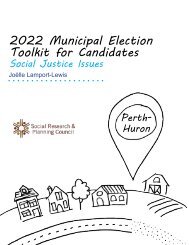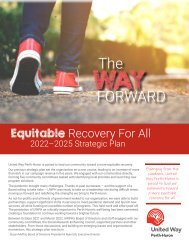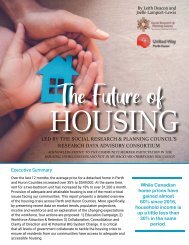2021 Supportive Housing Report
This report is designed to help enhance an understanding of homelessness and the role supportive housing can play within a larger strategy to end chronic homelessness. It provides an overview of best practices being implemented to address chronic homelessness; references supportive housing strategies that help people with the most complex mental health and addiction needs to stabilize their housing; and offers strategic actions for consideration to support the Huron and Perth communities toward achieving their goals of eradicating chronic homelessness and supporting their most vulnerable citizens.
This report is designed to help enhance an understanding of homelessness and the role supportive housing can play within a larger strategy to end chronic homelessness. It provides an overview of best practices being implemented to address chronic homelessness; references supportive housing strategies that help people with the most complex mental health and addiction needs to stabilize their housing; and offers strategic actions for consideration to support the Huron and Perth communities toward achieving their goals of eradicating chronic homelessness and supporting their most vulnerable citizens.
You also want an ePaper? Increase the reach of your titles
YUMPU automatically turns print PDFs into web optimized ePapers that Google loves.
practices approach used by case managers to assess the<br />
number and severity of issues faced by their clients.<br />
Additionally, management can review client acuity data<br />
and balance program resources accordingly.<br />
An example of an evidence-informed system of<br />
assessment widely used in homelessness programs is<br />
the Service Prioritization Decision Assistance Tool<br />
(SPDAT). It was designed as a tool to help front-line<br />
workers prioritize housing services for homeless<br />
individuals based upon their acuity or level of need. In<br />
the SPDAT, acuity is expressed as a number with a<br />
higher number representing more complex, cooccurring<br />
issues that are likely to impact a person or<br />
family’s overall housing stability. 60 The tool helps case<br />
workers and service providers to prioritize who to serve<br />
next based on their need and identifying the areas in<br />
the person/family’s life where support is most likely<br />
necessary in to avoid further homelessness and housing<br />
instability. The SPDAT assesses people’s needs based on<br />
a variety of components ranging from health to daily<br />
living activities to prioritize them for housing assistance<br />
interventions, sequence clients to receive those<br />
services, allocate the time and resources from staff, and<br />
assist with case planning and tracking of needs. 61<br />
The SPDAT is a lengthy form that takes time to walk<br />
through with clients and is often administered across<br />
multiple discussions with a client. In response to the<br />
time commitment of administering the SPDAT, a<br />
specialized and shorter version of the SPDAT tool, the<br />
Vulnerability Index – Service Prioritization Decision<br />
Assistance Tool (VI-SPDAT) was developed. The VI-<br />
SPDAT is a brief survey that can be conducted to quickly<br />
determine whether a client has high, moderate, or low<br />
vulnerability when initially presenting in the homeless<br />
system. The use of a pre-screen triage tool helps<br />
identify the most vulnerable clients and prioritize who<br />
should be given a full SPDAT assessment first. 62 Both<br />
local Service Managers are now using versions of the VI-<br />
SPDAT to triage people who consent to be on local<br />
name lists. 63<br />
OrgCode Consulting, co-creators of the VI-SPDAT,<br />
cautions communities not to rely solely on the tool to<br />
make decisions about ranking and matching within their<br />
The administration and funding of supportive housing<br />
Coordinated Access System. Explaining the VI-SPDAT<br />
providers were not downloaded to the municipal<br />
was designed as a triage tool within a more<br />
service managers in 2001; the responsibilities were<br />
comprehensive assessment system including: self-<br />
transferred to the provincial ministry that funded the<br />
support services during that time. As a result, the<br />
12 <strong>Supportive</strong> <strong>Housing</strong><br />
reporting by clients; factual observations; a full SPDAT;<br />
documentation and service data; and with client<br />
consent, information other professionals may have to<br />
contribute to understanding the specific needs of the<br />
household.<br />
As a result of frequent and repeated use by<br />
communities of the VI-SPDAT as a sole decision,<br />
assessment and matching tool, OrgCode recently<br />
announced its intention to retire the VI-SPDAT, stating<br />
“OrgCode will no longer be investing time or resources<br />
in updating and supporting the VI-SPDAT, although the<br />
full SPDAT as a service planning and case management<br />
tool will continue”. 64 In light of this announcement, it is<br />
recommended that both Service Managers review their<br />
use of the VI-SPDAT and plan for ultimate replacement<br />
of the tool.<br />
Effective discharge planning is another important<br />
element of a strong housing system of care. Effective<br />
discharge planning includes preparing someone who<br />
has lived in an ‘institutionalized’ setting, such as a<br />
hospital, a corrections facility, a child welfare<br />
facility/program, an addiction treatment facility, or a<br />
mental health program for life after discharge. Effective<br />
discharge planning should be collaborative and included<br />
as part of a housing system framework to identify<br />
appropriate housing and prevent these individuals from<br />
falling into homelessness. 65<br />
<strong>Housing</strong> and homelessness needs are varied and often<br />
complex. Equally, the solutions are multifaceted and<br />
broad. A coordinated system of access, assessment,<br />
support, and referral is key to seamlessly link people to<br />
the appropriate services of care within the broader<br />
system of supportive housing, community services and<br />
healthcare.<br />
Who is responsible for <strong>Supportive</strong> <strong>Housing</strong>?<br />
Researchers, practitioners, and clients often lament the<br />
disjointed nature of policy and program implementation<br />
as experienced on the ground by vulnerable groups.<br />
Policies frequently seem to counter their stated intent,<br />
or that of another government ministry. 66

















